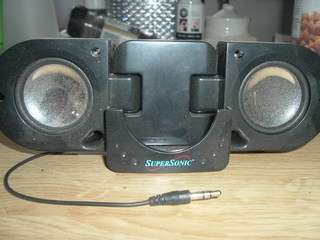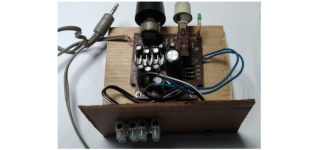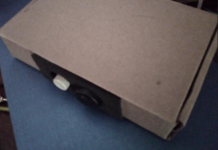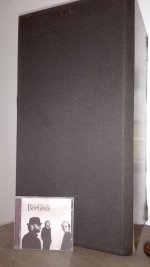Saw your amp. Very brave to mount it on a CD. I like the way you put the power supply inside the case, but what do you think of fire hazards -
http://www.diyaudio.com/forums/chip-amps/270187-tda-1519aq.html
http://www.diyaudio.com/forums/chip-amps/270187-tda-1519aq.html
Update: it is possible to run the amp off a 9V DC suppy. Tested with a 9V battery and it works.
I will be installing the electronics in a larger amplifier case.
I will be installing the electronics in a larger amplifier case.
I tore apart a set of Sony computer speakers and stole the amp. The power supply was a 9 volt D.C. wall wart. I use a LM7809 regulator for a cheap way to operate the amp from my 12 volt house battery. Not the most efficient regulator but it was easy to find and use at the time..
The D.C. input to the regulator can be anywhere between 10 to 32 v.d.c. and will handle a 1 amp load with a heat sink. In most cases with small amps, the heat sink is not needed..
I found these little guys and have used them many times. Very reliable and versatile. Shop around and you can find them much cheaper..
10pcs RC Airplane Module Mini 360 DC Buck Converter Step Down Module 4.75V 23V to 1V 17V 17x11x3.8mm New LM2596-in Integrated Circuits from Electronic Components & Supplies on Aliexpress.com | Alibaba Group
The D.C. input to the regulator can be anywhere between 10 to 32 v.d.c. and will handle a 1 amp load with a heat sink. In most cases with small amps, the heat sink is not needed..
I found these little guys and have used them many times. Very reliable and versatile. Shop around and you can find them much cheaper..
10pcs RC Airplane Module Mini 360 DC Buck Converter Step Down Module 4.75V 23V to 1V 17V 17x11x3.8mm New LM2596-in Integrated Circuits from Electronic Components & Supplies on Aliexpress.com | Alibaba Group
Nice to see some pictures if you have them. I take it you are off grid - so the low power amp makes a lot of sense - and a lot of noise for a small amp.
Edit- Noise means music output not the bad kind.
Edit- Noise means music output not the bad kind.
I took one of these and made a portable test amp from it. It operated from 4-"AA" cells or 6 volts. I hot glued a LM7806 in the battery holder area and connected the output of the regulator to the proper battery connections. Took the speakers and housings off of the main case and ran a length of wires from the amp to connect to speakers. Worked out well..

Here's one project that I did with the amp..
https://imageshack.com/a/XD0q/1
And yes.. I'm totally off the power grid and have been since 1989. Whole system operates at 12 V.D.C.

Here's one project that I did with the amp..
https://imageshack.com/a/XD0q/1
And yes.. I'm totally off the power grid and have been since 1989. Whole system operates at 12 V.D.C.
Last edited:
So you made a boombox. I was thinking more on the lines of a mini-hifi system like these
Best mini hi-fi systems reviewed: Panasonic, Denon, Cambridge Audio and more (Wired UK)
Its difficult to maintain an entire family off grid, the TV becomes an essential item.
Best mini hi-fi systems reviewed: Panasonic, Denon, Cambridge Audio and more (Wired UK)
Its difficult to maintain an entire family off grid, the TV becomes an essential item.
If you have a design for an amp/source combo, you can connect to many different types of standard house speakers. That little ElCheepo that I converted was , at one time for giggles, connected to a large set of Klipsch floor standers. The amp just increases the noise that you put into it. You have choices of what to connect the amp to. Just use your imagination and play within the limits of the amp..
You'll love this. A bare bone $.34 - 5 volt chip amp (3w/Ch.) with a USB Bluetooth receiver as the audio source driving 4 Kenwood surround sound speakers. (4 Ohm/Channel) 2 bank batteries can make a lot of noise! Sounds impressive.. 😉
https://imageshack.com/a/IZw4/1
I have a 74" projection TV/DVD system in my living room. It draws ~7 amps through a 12-19.5 volt converter from my battery. I use a Jensen motorhome head (AWM975) for the audio/video which drives 4 speakers. (2 Klipsch and 2 RCA) All remote control..
I also have a 19" TV/DVD combo in the bedroom mounted to a hinged arm above the bed. 2 Sony speakers mounted to the ceiling with a Lepai LP-808 amp. Source is the TV headphone jack through an isolation transformer to avoid ground loop issues. (They both power from the 12 v.d.c. house battery direct) Amplified outdoor antenna system supplying both..
The imagination is a beautiful thing..
You'll love this. A bare bone $.34 - 5 volt chip amp (3w/Ch.) with a USB Bluetooth receiver as the audio source driving 4 Kenwood surround sound speakers. (4 Ohm/Channel) 2 bank batteries can make a lot of noise! Sounds impressive.. 😉
https://imageshack.com/a/IZw4/1
I have a 74" projection TV/DVD system in my living room. It draws ~7 amps through a 12-19.5 volt converter from my battery. I use a Jensen motorhome head (AWM975) for the audio/video which drives 4 speakers. (2 Klipsch and 2 RCA) All remote control..
I also have a 19" TV/DVD combo in the bedroom mounted to a hinged arm above the bed. 2 Sony speakers mounted to the ceiling with a Lepai LP-808 amp. Source is the TV headphone jack through an isolation transformer to avoid ground loop issues. (They both power from the 12 v.d.c. house battery direct) Amplified outdoor antenna system supplying both..
The imagination is a beautiful thing..
Last edited:
All this off Solar power? Impressive. I am looking into going for a daytime solar system to reduce costs - maybe discuss this on the Everything Else - diyAudio ?
Sure.. Get a thread going. Maybe we can draw out some others around here that are using solar or other power sources..
Most every project I build is battery powered and portable. I only have one 120 v.a.c. power strip connected to a 400 watt inverter. Might use it once a week.. (Or when I'm soldering)
I've purchased brand new audio items, took them home and immediately torn them apart to convert them. Makes my wife cringe.. 🙂
Most every project I build is battery powered and portable. I only have one 120 v.a.c. power strip connected to a 400 watt inverter. Might use it once a week.. (Or when I'm soldering)
I've purchased brand new audio items, took them home and immediately torn them apart to convert them. Makes my wife cringe.. 🙂
Build the box first. This phase is complete. It runs, it works, producing a clarity of sound I have never experienced before, with bass that is sufficiently solid so I do no miss its depth. With the desktop Open Baffle speakers, this is a huge success, as far as I am concerned. My car system sounds muddy, and the vintage system sounds impressive and capable but lacks the detail. Onward then...
Great with large speakers
Right now running this hooked up to large Sony ES 333 speakers. How does it sound?
It is a little short on dynamics, which is to be expected with 1.2 W per channel into large 8 Ohm speakers. The speakers are old, so the trebles are not very evident, with any amplifier. The bass is present, and adds that extra dimension to the music missing in my desktop open baffles and smaller speakers.
Where it does shine ( I am running it off a HTC Explorer phone through Bluetooth to a Bluetooth car adapter ) is in the mid range. Vocals are expressive, mire expressive than I have heard in a long time, there is no background noise and the mid range is ultra smooth. The chip is a TEA 2025B, and itself is about 10 years old, if you recall, salvaged from PC speakers that were not working.
Who needs 200 W. 25 Would be good.
Right now running this hooked up to large Sony ES 333 speakers. How does it sound?
It is a little short on dynamics, which is to be expected with 1.2 W per channel into large 8 Ohm speakers. The speakers are old, so the trebles are not very evident, with any amplifier. The bass is present, and adds that extra dimension to the music missing in my desktop open baffles and smaller speakers.
Where it does shine ( I am running it off a HTC Explorer phone through Bluetooth to a Bluetooth car adapter ) is in the mid range. Vocals are expressive, mire expressive than I have heard in a long time, there is no background noise and the mid range is ultra smooth. The chip is a TEA 2025B, and itself is about 10 years old, if you recall, salvaged from PC speakers that were not working.
Who needs 200 W. 25 Would be good.
Attachments
Last edited:
Heck.. I'm happy with 3 watts!
I love these little amps.. 2.1.. 15w/ch. and 1 sub out at 30 watts.. Crossover built in at ~130 and down..
They run very nice at 12 v.d.c. BUT when ya add a sub out control, the wiring to the control picks up the oscillator in the chips and sounds like crap. (Background noise in the sub. out.)
Wholesale 10pcs/lot Brand new Mini HI FI High power 2.1 DC10 18V Digital Amplifier Board 15W*2+30W Class D Amplifier 10001040|amplifier board|class d amplifierd amplifier - AliExpress
I fixed that issue..
I love these little amps.. 2.1.. 15w/ch. and 1 sub out at 30 watts.. Crossover built in at ~130 and down..
They run very nice at 12 v.d.c. BUT when ya add a sub out control, the wiring to the control picks up the oscillator in the chips and sounds like crap. (Background noise in the sub. out.)
Wholesale 10pcs/lot Brand new Mini HI FI High power 2.1 DC10 18V Digital Amplifier Board 15W*2+30W Class D Amplifier 10001040|amplifier board|class d amplifierd amplifier - AliExpress
I fixed that issue..
An externally hosted image should be here but it was not working when we last tested it.
Last edited:
These guys are ultra sweet! The shipping is ???? but they are really good!!
Free Shipping!!! 5V 2.1 + 3D Surround subwoofer / mini amplifier board / USB subwoofer / Electronic Component|component electronic|board boardsubwoofer components - AliExpress
Free Shipping!!! 5V 2.1 + 3D Surround subwoofer / mini amplifier board / USB subwoofer / Electronic Component|component electronic|board boardsubwoofer components - AliExpress
Hey OffGrid.
Could you give me a run through of how to handle power supplies? The TEA 2025 is running off a AC DC adapter without any filtering added to the board, originally powered by direct AC, transformer and a diode bridge on the board.
I am running around trying to hook up the power supply to my dual LM386 amplifier I have to settle using two separate 9V batteries or two separate adapters - too much peak distortion otherwise.
Could you give me a run through of how to handle power supplies? The TEA 2025 is running off a AC DC adapter without any filtering added to the board, originally powered by direct AC, transformer and a diode bridge on the board.
I am running around trying to hook up the power supply to my dual LM386 amplifier I have to settle using two separate 9V batteries or two separate adapters - too much peak distortion otherwise.
Thanks for the recommendations, the price is right with the second one, however what is the chip they use? Must be a well known one. I am a little wary of class D after the my Lepai - clone fiasco in 2015.
The TEA 2025 will operate with a voltage between 3 to 12 volts DC but will be limited to the maximum voltage rating of the electrolytic filtering capacitor on the amp board. Same goes for the LM386 amp.. (2.7 - 9 volts DC) Either one will require a reserve amperage of less than 2 amps. You can have an amperage reserve of 20 amps in a power supply as long as the voltage is correct. The higher the amp reserve, the less chance of distortion BUT more reason to include some in line fusing.. LOL..
Are you thinking portable or stationary usage?
Are you thinking portable or stationary usage?
- Home
- Amplifiers
- Chip Amps
- PC Speaker electronics to amplifier conversion


